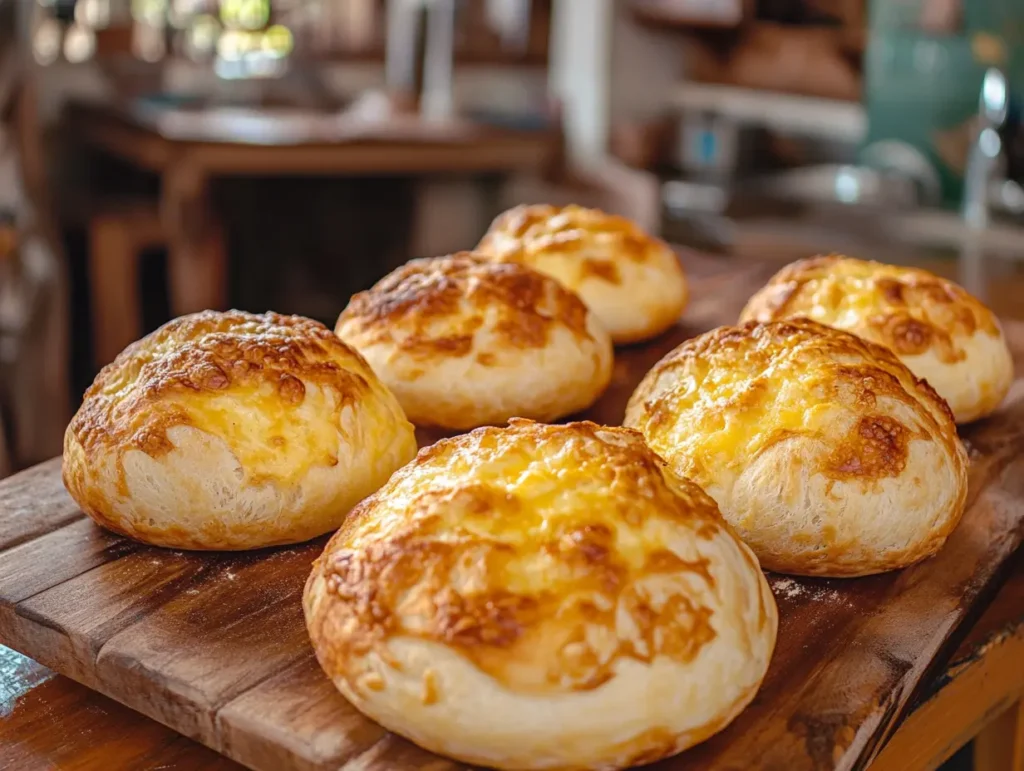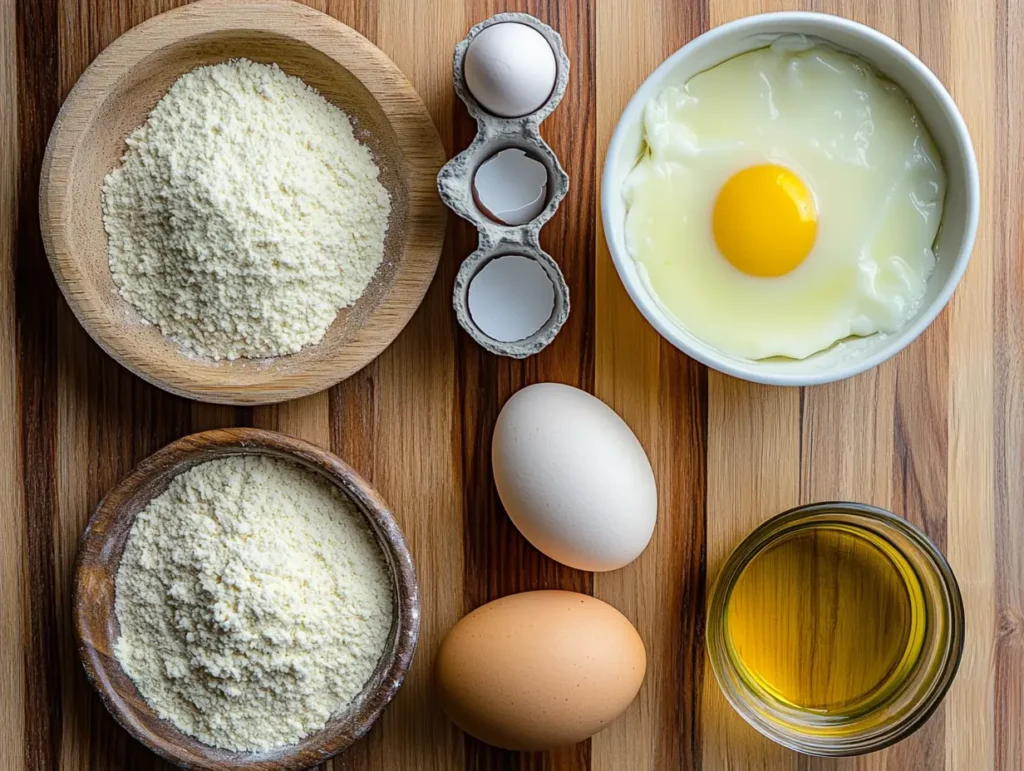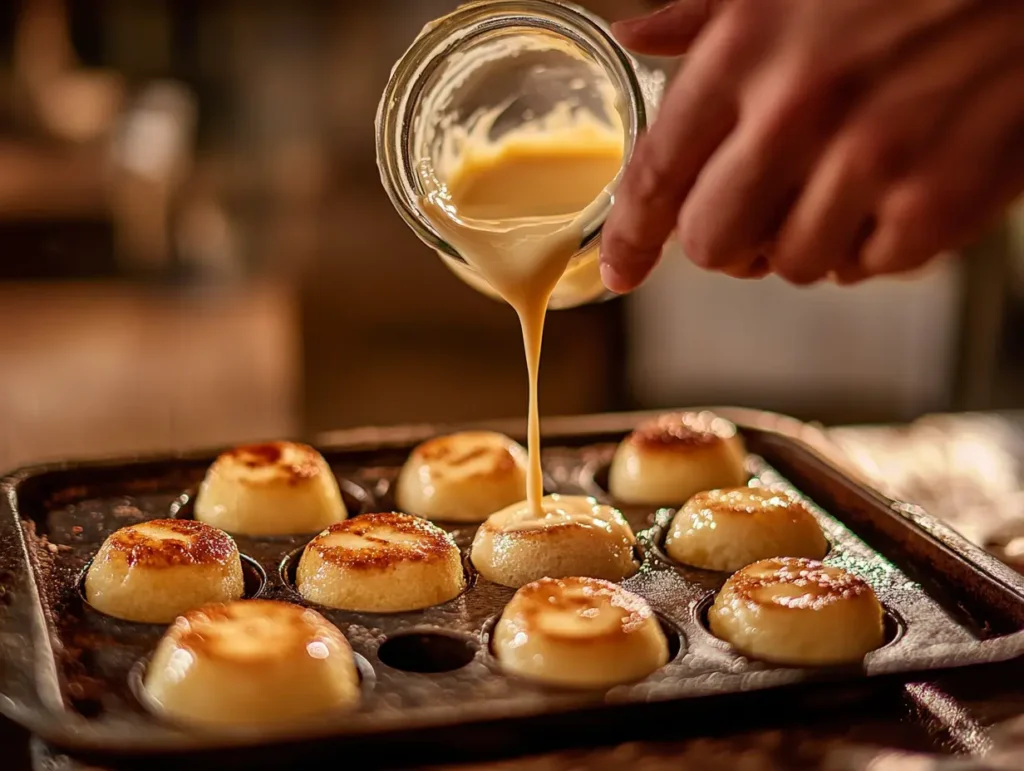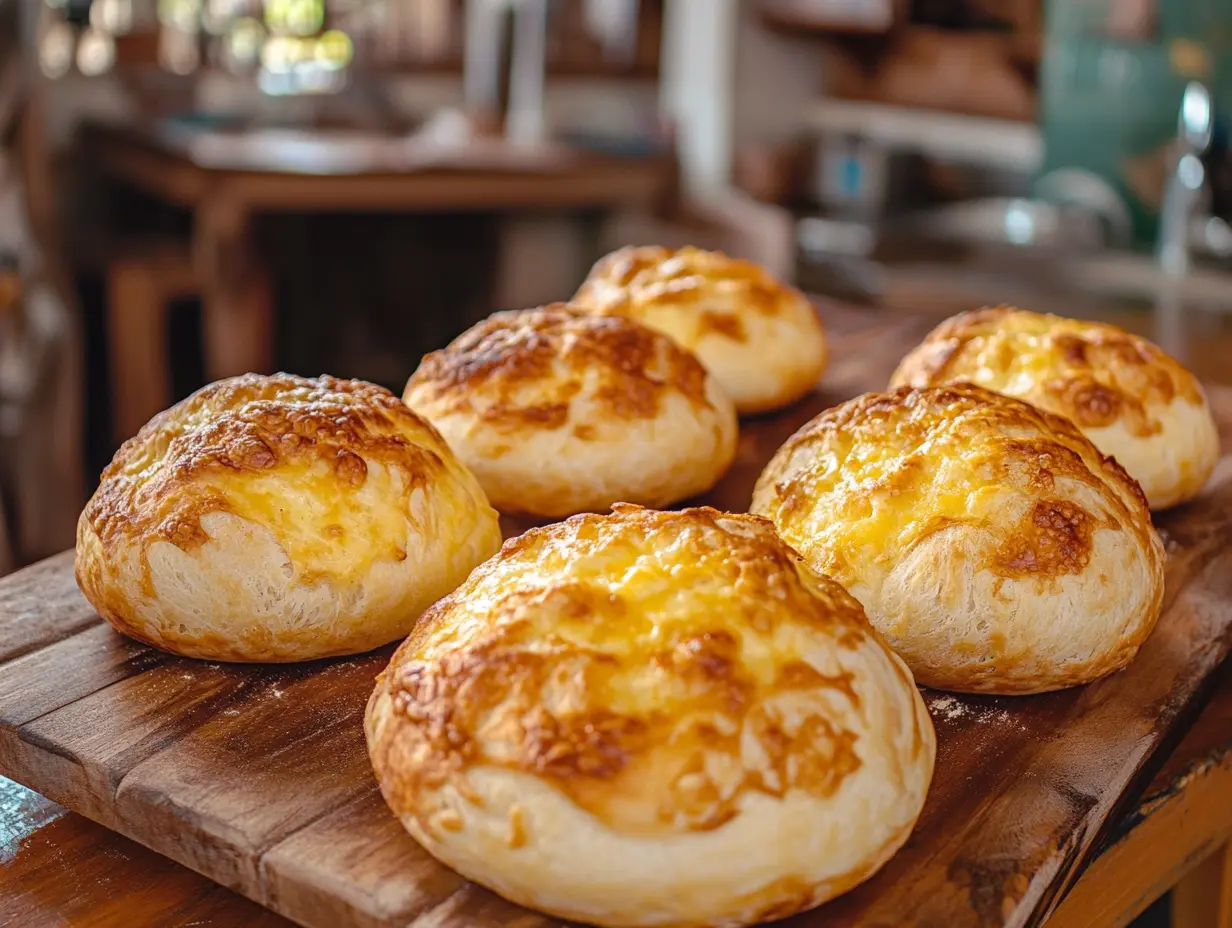Brazilian Cheese Bread Recipe: The Irresistible, Chewy Delight You’ll Crave Daily

Brazilian cheese bread recipe—those four words alone are enough to make my southern kitchen come alive with the smells of toasty cheese and chewy magic. Hey y’all, Ellie Mae here from my little farmhouse just outside Asheville, and today, I’m sharing one of my most addictive kitchen finds to date. This gem comes courtesy of a dear friend’s Brazilian wife and has lived on repeat in my oven ever since.
It’s called Pão de Queijo, which literally means “cheese bread,” and it’s not your average roll. Picture a golden crust that gives way to a warm, cheesy center with just the right stretch—it’s naturally gluten-free and downright hard to stop eating. The best part? You can make the batter in a blender and pop it in a mini muffin pan. That’s it. And yes, you can make just a few at a time—if you can resist eating the whole tray!
Before we dive into the how-to, check out this quick cheesy fix:
Discover great ideas like this Boursin Cheese Recipe here: Boursin Cheese Recipe
Let’s explore the delicious world of pão de queijo from ingredients to tradition—and a few twists along the way.
The Origins of Brazilian Cheese Bread Recipe
– History of Pão de Queijo in Brazilian Cuisine
Brazil’s food story is packed with bold flavors, tropical ingredients, and a whole lotta soul—and pão de queijo holds a sacred spot at the table. This beloved Brazilian cheese bread recipe dates back to the 18th century, deep in the Minas Gerais region where dairy farms and cassava fields ruled the land.
Folks didn’t have wheat flour back then, so they leaned into cassava, a root vegetable native to South America. What they discovered was tapioca starch, pulled from the cassava root’s milky pulp. When mixed with local cheese and eggs, it created a chewy, cheesy bread that felt like a celebration every time.
From humble colonial kitchens to modern-day cafés across São Paulo and Rio, pão de queijo has risen from resourceful invention to iconic comfort food. Brazilians eat it with breakfast, serve it as a snack with coffee (cafezinho), or roll it out for special get-togethers. It’s one of those rare dishes that feels just as right with a glass of fresh juice in the morning as it does beside a sizzling platter of steak at night.
– How Regional Variations Shape the Flavor
Just like hush puppies or biscuits here in the South, Brazilian cheese bread has its own flavor twist depending on where you’re eating it. In some homes, it’s a little salty and stretchy thanks to aged cheese. In others, it’s fluffy and mild, designed to soak up butter or dip into hearty soups.
Minas cheese (queijo Minas padrão) is the traditional go-to, but outside of Brazil, folks use what they have—sharp cheddar, mozzarella, Parmesan, or even farmer’s cheese. Some versions incorporate mashed potatoes (yes, really!) or sweet touches like anise seed for a surprise bite.
In my own kitchen, I love experimenting. I’ve tried it with smoky Gouda, spicy pepper jack, and even a mix of leftover cheeses from my fridge drawer. It’s proof that this recipe isn’t just about authenticity—it’s about joy, flexibility, and using what you’ve got.
Looking for inspiration? Try our Snacks & Sides section for more cheesy ideas that pair beautifully with pão de queijo.
Essential Ingredients in a Brazilian Cheese Bread Recipe

– Why Tapioca Flour is Non-Negotiable
If there’s one thing that makes Brazilian cheese bread different from your average cheese roll, it’s tapioca flour. Not wheat flour. Not almond flour. Tapioca flour, also called tapioca starch, is what gives pão de queijo its signature chew—light, springy, and oh-so-satisfying.
Made from the starchy pulp of the cassava root, tapioca flour is naturally gluten-free, making this recipe a top pick for anyone dodging wheat. And unlike cassava flour, which uses the whole root and adds more fiber and density, tapioca flour gives a silkier, more elastic texture. That’s the magic trick behind the puffed-up shape and chewy center.
A lot of folks confuse cassava flour and tapioca flour—they’re related but not interchangeable here. Use the wrong one, and you’ll end up with dense bread instead of pillowy bites. I’ve learned that the hard way, y’all. So when shopping, double-check that the label reads “tapioca flour” or “tapioca starch.” Brands like Bob’s Red Mill or Otto’s are my go-tos.
If you want to keep your pantry gluten-free and ready to whip up pão de queijo anytime, stock up. This flour’s also great in gravies, pie fillings, and chewy cookies.
– Choosing the Right Cheese: From Queso Fresco to Cheddar
When it comes to the cheese in Brazilian cheese bread, the possibilities are deliciously wide open. Traditional recipes call for queijo Minas, a fresh, slightly tangy cheese found mostly in Brazil. But here in the States, you’ve got options—and they all bring a little something different to the party.
Here’s a breakdown of what works well:
| Cheese Type | Flavor Profile | Texture Result |
|---|---|---|
| Parmesan | Salty, nutty | Crisp outside, chewy inside |
| Mozzarella | Mild, stretchy | Very chewy, soft center |
| Queso Fresco | Tangy, crumbly | Light, airy finish |
| Sharp Cheddar | Bold, savory | Golden crust, gooey core |
| Pepper Jack | Spicy, creamy | Adds a kick with great melt |
| Gouda (young) | Slightly sweet, smooth | Buttery and rich |
Personally, I love combining cheeses. A 70/30 split between a melty cheese like mozzarella and a flavor-packed one like Parmesan is my sweet spot. Just remember—grate your cheese fresh if you can. Pre-shredded cheeses often have anti-caking agents that mess with texture.
Also, keep an eye on salt levels. If your cheese is naturally salty (like Parmesan), you may want to reduce the added salt in your batter just a smidge.
Don’t miss our Blue Cheese Salad for a bold pairing idea that elevates your cheese game even further.
The Best Method: Quick Blender Approach
– Step-by-Step Blender Technique
Now, if you’re anything like me—juggling dinner, laundry, and maybe a toddler on your hip—you’ll appreciate a shortcut that doesn’t skimp on flavor. That’s where the blender method for this Brazilian cheese bread recipe shines. No kneading, no fancy mixers—just one pitcher and one pan.
Here’s how I do it, and trust me, it’s foolproof:
- Preheat your oven to 400°F. Lightly grease a mini muffin tin with olive oil or butter. This helps give the bread that golden edge and prevents sticking.
- Add to a blender:
- 1 large egg (room temp)
- 1/3 cup olive oil
- 2/3 cup milk
- 1 ½ cups tapioca flour
- ½ cup shredded or crumbled cheese
- 1 tsp salt (adjust to taste)
- Blend until smooth—you might need to stop and scrape down the sides once or twice. The mixture should glide from your blender but still hold a bit of body—kind of like if cake batter and custard had a baby.
- Pour into muffin wells, filling each one about ¾ full. Don’t overfill or they’ll spill as they puff.
- Bake for 15-20 minutes, or until the tops are puffed and golden-brown. The inside will still be chewy, just like it’s meant to be.
- Let cool for a minute or two before serving (but honestly, I always pop one in my mouth straight out of the pan).
And here’s a game-changer—the batter can be stored in the fridge for up to a week. Just give it a good stir before baking and you’ve got hot, cheesy bread whenever the craving hits. Come summertime, I’ll fire up the toaster oven instead of heating the whole house—still gets the job done without breaking a sweat.
Looking for inspiration? Try our Bakes & Casseroles collection for warm, cheesy ideas to serve alongside these bread bites.
– Storage Tips: Making the Batter Last for Days
Having a bowl of batter on hand is like having a secret weapon. Hungry kids? Cheese bread. Unexpected guests? Cheese bread. Rainy afternoon? You guessed it—cheese bread.
Here’s how to make it last and reheat like a dream:
- Refrigerate the batter in an airtight container for up to 7 days. Let it sit at room temp for 10–15 minutes before using.
- Bake only what you need—these are best fresh.
- Reheat leftovers in the toaster oven for 1–2 minutes. Microwave works in a pinch, but you’ll lose that crispy edge.
- Freeze baked bread for up to a month. Reheat straight from the freezer at 350°F until warmed through and crisp again.
This is hands-down my go-to method. And when I say it’s addictive, I mean I’ve eaten half a tray in one sitting with a cup of coffee. No regrets.
Check out our Dairy-Free Ricotta Cheese Recipe for a clever variation if you need to skip the dairy altogether.
Traditional Method: Hand-Kneaded Dough with Potatoes
– The Classic Cassava and Potato Version
While the blender version of the Brazilian cheese bread recipe is my go-to on a busy Tuesday night, there’s something special about doing it the old-fashioned way. This method is rooted in home kitchens across Brazil—where hot potatoes, tapioca starch, and strong hands work together to knead love right into the dough.
I first learned this technique from a Brazilian friend who swore by it. She told me the flavor hits differently—and she wasn’t wrong. When you blend mashed potatoes with polvilho azedo (sour cassava starch), the result is a slightly denser roll with even more stretch and a subtle tang.
Here’s how the traditional recipe shakes out:
Ingredients:
- 1 kg sour tapioca starch (polvilho azedo)
- 1 kg cooked, mashed potatoes (hot)
- 250 ml room temp milk
- 250 ml vegetable oil
- 1 tbsp salt
- 1 lb queso fresco or panela, grated
- 6 free-range eggs
- Optional: 1 tsp anise seeds for a flavor twist
Method:
- Start by adding your hot mashed potatoes to the bowl of tapioca starch. The heat helps break down the starch and makes kneading easier.
- Add salt and begin mixing by hand—no spoons, no mixers, just you and the dough.
- Gradually add milk and oil as you continue kneading. The dough will start to come together.
- Stir in your cheese and, finally, beat in the eggs. Add an extra egg if the dough feels dry or cracks when shaped.
- Work the dough until it feels silky between your fingers and stretches without tearing—like a well-worn quilt that still holds its shape. It should be firm enough to shape into small balls without sticking to your hands.
- Shape the dough into little rounds and set ’em gently on a baking tray lined with parchment so they don’t stick and clean-up stays easy.
- Slide the tray into a 450°F oven and let those little beauties bake for about 20 minutes, or until they puff up and turn a lovely golden brown like sunset biscuits.
This recipe is more hands-on and time-intensive, but y’all—it’s worth it. It reminds me of making homemade biscuits with my grandma: messy, a little chaotic, but full of heart.
– Baking Tips for Silky, Moldable Dough
Working with tapioca starch can feel tricky at first. It’s not like all-purpose flour—it doesn’t soak up liquid the same way. That’s where the warmth of your ingredients—especially those taters—really makes a difference in bringing the dough together just right. Always mix while they’re still warm to help the starch blend smoothly.
Here are a few pro tips:
| Tip | Why It Matters |
|---|---|
| Use hot potatoes | Helps absorb the starch and smooth the dough |
| Add eggs last | Maintains dough texture and structure |
| Dough breaking? | Add 1 more egg or a splash of milk |
| Too sticky? | Lightly oil your hands, don’t add more starch |
| Want more stretch? | Use sour starch (polvilho azedo), not sweet |
This traditional take on the Brazilian cheese bread recipe gives you a rustic, deeply satisfying version of pão de queijo. Great for weekends, holidays, or whenever you’ve got time to slow down and get your hands a little doughy.
Discover great ideas like this in our Snacks & Sides section, packed with comforting bites and creative twists.
Customizing Your Brazilian Cheese Bread Recipe

– Add-Ins: Herbs, Spices, and Unexpected Twists
One of the most fun parts about making a Brazilian cheese bread recipe at home is that once you’ve nailed the basics, you can dress it up any way you like. This isn’t just a recipe—it’s a canvas for flavor.
Whether you’re cooking for your kids, your neighbors, or just sneaking a warm one off the tray for yourself (been there), this cheese bread is begging for a personal touch. The classic pão de queijo is perfect on its own, but I like to throw in a few extras to suit the season or the mood.
Here are some flavorful ideas to turn your basic Brazilian cheese bread recipe into something unforgettable:
| Add-In | What It Does | How to Use |
|---|---|---|
| Fresh chopped rosemary | Adds herby depth | Mix into batter before baking |
| Garlic powder | Boosts savory flavor | Blend with wet ingredients |
| Smoked paprika | Adds color + warmth | Dust tops before baking |
| Diced jalapeños | Brings the heat | Stir in with cheese |
| Shredded pepper jack | Extra melty and spicy | Use instead of or with Parmesan |
| Crumbled bacon | Adds salty, meaty bite | Fold in after blending |
| Anise seeds | A Brazilian twist | Add 1 tsp to dough before shaping |
I’ve tested this Brazilian cheese bread recipe with all kinds of ingredients, and let me tell you—it’s hard to mess up. I’ll never forget the batch where I tossed in a handful of sharp cheddar and a pinch of cracked pepper—the whole kitchen smelled like a southern smokehouse, and the flavor? Let’s just say they didn’t make it past the front porch. Another time I added pimento cheese (because, well, Southern roots), and it turned out so creamy I barely got them off the tray before they were gone.
The base Brazilian cheese bread recipe is forgiving, but balance is still key. Don’t overdo it—especially with wet or salty additions. Just a touch of something extra can turn a simple batch into something downright unforgettable.
– Serving Suggestions for Every Occasion
This Brazilian cheese bread recipe is not just for snacks—it can shine at any meal. I’ve made it for breakfast, tucked it into lunchboxes, and served it up with Sunday roasts. Whether you’re hosting or just hangry at 3 p.m., here’s how to make it work:
For breakfast:
Start your day with a few warm cheese breads alongside black coffee or orange juice. Try smearing a bit of guava paste on top for a real Brazilian breakfast twist.
For lunch or brunch:
Tuck these cheesy bites next to a veggie soup or crisp salad. They’re a fantastic gluten-free substitute for bread rolls and so much more flavorful.
As an appetizer or party snack:
Pile them high on a wooden board with sliced cured meats, olives, and dips. Your Brazilian cheese bread recipe will be the star of any grazing table.
With dinner:
Serve them hot with roasted chicken or steak. They’re especially good beside saucy dishes like chili or creamy casseroles.
In lunchboxes or on the go:
Cool a few down, wrap in wax paper, and toss them in your kiddo’s lunch for a portable treat that feels like a hug from home.
If you’re hunting for more cheese-forward ideas, check out our Boursin Cheese Recipe for a creamy companion that pairs like a dream.
This Brazilian cheese bread recipe isn’t just easy—it’s endlessly versatile. Whether you spice it up or keep it classic, the result is always the same: gone in minutes and asked for again tomorrow.
What Makes Brazilian Cheese Bread So Chewy and Puffy?
– The Science Behind the Puff: Steam and Starch
Ever bite into a piece of Brazilian cheese bread and wonder how it’s both chewy and airy at the same time? Well, y’all, it’s not magic—it’s smart kitchen chemistry built into this timeless Brazilian cheese bread recipe.
The puff comes from steam. When you bake that tapioca-based batter at a high temperature—usually around 400°F or more—moisture inside the batter quickly turns to steam. That steam causes the dough to rise and puff, giving you that signature hollow center and golden dome on top.
Tapioca starch, the heart of any Brazilian cheese bread recipe, behaves differently than wheat flour. It doesn’t form gluten, which means the texture doesn’t come from long strands or stretchiness. Instead, it creates a gel-like chewiness that holds together beautifully while letting the outside crisp up. That contrast—crispy shell, chewy inside—is exactly what makes each bite so satisfying.
It’s also why the Brazilian cheese bread recipe works so well in a mini muffin tin. The smaller size helps the bread heat evenly and rise quickly, forming that golden crust with a gooey, stretchy interior.
Want that bakery-perfect puff every time? Keep your oven fully preheated before baking. And don’t peek too early—opening the oven door too soon can cause a collapse. Let those beauties bake in peace.
– Common Baking Mistakes and How to Avoid Them
Even the best Brazilian cheese bread recipe can flop if you miss a step. I’ve had my fair share of lopsided loaves and sticky messes, but each misstep taught me something better—so consider these tips straight from my own flour-dusted learning curve.
| Mistake | Why It Happens | How to Fix It |
|---|---|---|
| Dough is too runny | Too much liquid or cold ingredients | Use room-temp ingredients and measure carefully |
| Bread didn’t puff | Oven not hot enough | Preheat to 400°F or higher and use a mini muffin tin |
| Gummy inside | Underbaked | Bake an extra 2–3 minutes and let rest before eating |
| Tough texture | Wrong flour used | Stick with tapioca flour, not cassava or cornstarch |
| Bland flavor | Mild cheese or underseasoned | Use sharp cheese and taste test your batter |
This Brazilian cheese bread recipe is forgiving, but like any good Southern recipe, it pays to respect the process. Think of it like biscuits—you can wing it a little, but not too much.
If you’re looking to serve these alongside a main dish, don’t miss our Bakes & Casseroles collection for hearty, cheesy meals that match up perfectly.
Gluten-Free Goodness and Dietary Perks
– Why It’s Perfect for Celiac or Gluten-Sensitive Diets
One of the things I love most about this Brazilian cheese bread recipe is that it’s naturally gluten-free—no special substitutions or fancy tricks needed. Unlike so many baked goods that require swaps or workarounds, this recipe was born from gluten-free roots.
The star ingredient here—tapioca flour—comes straight from the cassava root and doesn’t contain any gluten at all. That makes the Brazilian cheese bread recipe a perfect fit for folks with celiac disease, wheat allergies, or anyone just cutting down on gluten. And let me tell you, you won’t miss a thing. The texture is chewy, the flavor is rich, and the experience? Totally comforting.
When I served this cheese bread recipe at a church potluck last fall, one sweet lady came up and hugged me after the first bite. “It’s the first bread I’ve eaten in months that didn’t upset my stomach,” she said. That moment right there reminded me why I love sharing this kind of recipe.
So whether you’re gluten-sensitive or cooking for someone who is, this Brazilian cheese bread recipe is a safe, satisfying option that won’t feel like a compromise.
– Comparing Cassava Flour vs Tapioca Flour
Now let’s clear up a common confusion—cassava flour and tapioca flour are not the same thing, and it really matters for this recipe. Both come from the same plant, but they’re processed differently, and only one gives you the light, chewy texture we love in this Brazilian cheese bread recipe.
| Flour Type | What It’s Made From | Works for This Recipe? | Texture Impact |
|---|---|---|---|
| Tapioca Flour | Starchy pulp of cassava root | ✅ Yes! | Light, stretchy, chewy |
| Cassava Flour | Whole cassava root | ❌ No | Dense, gummy, crumbly |
Tapioca flour is ultra-fine, almost powdery, and when it hits heat, it puffs and stretches just the way we want it to in this Brazilian cheese bread recipe. Cassava flour, bless its heart, adds a heaviness that just doesn’t let the dough puff or stretch the way we need for this Brazilian cheese bread recipe—it ends up more like a dense biscuit than that chewy bite we’re after.
So if you’re cruising down the baking aisle or scrolling online, make sure your bag says tapioca flour or tapioca starch. That detail makes all the difference between a fluffy bite and a doughy dud.
If you’re curious about dairy alternatives too, don’t miss our Dairy-Free Ricotta Cheese Recipe for another creamy, gluten-free kitchen win.
Pairing Ideas — What to Serve with Brazilian Cheese Bread
– Brazilian Steakhouse-Style Pairings
If you’ve ever been to a Brazilian steakhouse, chances are the first thing that hit your table—hot, puffy, and impossible to resist—was a little roll of heaven: pão de queijo. That’s the very same treat you get with this Brazilian cheese bread recipe. But don’t think for a second it only belongs in fancy restaurants. You can bring that same indulgent combo right to your home kitchen.
For a full-on Brazilian-style dinner, pair your freshly baked cheese breads with:
- Grilled picanha (Brazilian beef cut)
- Garlic butter shrimp
- Sautéed collard greens or kale with olive oil
- Black bean stew (feijoada) with rice
- Chimichurri or spicy vinaigrette for dipping
Trust me, this Brazilian cheese bread recipe makes a phenomenal sidekick to anything smoky, salty, or saucy. The chewy texture and cheesy pull balance out bold proteins and elevate your whole plate.
And here’s a little secret: I sometimes slice them in half and make tiny sliders with pulled pork or leftover roast beef. It’s not traditional—but it is delicious.
– Perfect Combos: Soups, Salads & Dips
Not feeling meat-heavy tonight? This Brazilian cheese bread recipe also shines beside lighter fare. In fact, it’s one of my go-to sides whenever I’m whipping up a weeknight soup or fresh garden salad.
Try these matchups:
| Dish | Why It Works with Brazilian Cheese Bread |
|---|---|
| Tomato basil soup | The bread’s chewiness soaks up the broth like a sponge |
| Butternut squash soup | Creamy meets cheesy—fall in a bowl |
| Caesar or arugula salad | Adds a warm contrast to crisp greens |
| Roasted veggie platters | Great for dipping and stacking |
| Spinach and artichoke dip | This bread becomes your edible spoon |
This Brazilian cheese bread recipe also makes a great brunch or snack table item. I’ll often serve a basket of them with soft cheeses, pepper jelly, or even a side of scrambled eggs. They’re bite-sized and always a crowd favorite.
One more tip? Warm them slightly before serving—it brings back the gooey magic and makes folks think they just came out of the oven.
Looking for more cozy bites to round out the table? Check out our Snacks & Sides section for recipes that play beautifully with pão de queijo.
Real Stories, Real Kitchens: My Journey with Pão de Queijo
– From Asheville to São Paulo: Why This Recipe Feels Like Home
The first time I tried pão de queijo, I wasn’t in a fancy bakery or a bustling street in Brazil. I was standing in my friend Bill’s kitchen, right here in North Carolina, while his Brazilian wife Silvia pulled a tray of golden rolls out of the oven. One bite and I was hooked. I asked for the Brazilian cheese bread recipe on the spot—and I’ve been baking it ever since.
Back then, I didn’t even know what tapioca flour was. But the texture? That chewy, cheesy goodness with a crisp edge? I couldn’t stop thinking about it. It reminded me of my Southern roots—of cornbread, biscuits, and that joy you feel when something warm and homemade hits just right.
Over time, I played with the original Brazilian cheese bread recipe, changing up cheeses, switching between mini muffin pans and full-size ones, even adding a pinch of rosemary from my garden. What I love most is how this recipe bridges cultures—bringing a little bit of Brazil into my Appalachian farmhouse kitchen.
– Lessons Learned from Flops to Perfection
Now, don’t let me fool you into thinking every batch came out perfect. My first try? I used cassava flour instead of tapioca flour (big mistake). Another time I used cheese that was way too mild, and the result was bland and dense.
But every time I messed up, I learned something new—and that’s the heart of cooking. This Brazilian cheese bread recipe has taught me to trust the process, to respect the ingredients, and to always—always—taste the batter before you bake.
I’ve shared this recipe with friends, neighbors, and even passed it out on index cards at church. It’s that kind of dish. Humble. Joyful. And just fancy enough to impress at your next dinner party.
So whether you’re baking it for the first time or the fiftieth, know that this Brazilian cheese bread recipe brings people together. It’s more than just bread—it’s memory, it’s connection, and it’s always worth a second helping.
For More Recipes Follow me on my Facebook Page : SavoryNest
FAQs
What kind of cheese is used in Brazilian cheese bread?
Traditionally, Brazilian cheese bread uses queijo Minas, a Brazilian cheese that’s slightly tangy and semi-soft. Outside Brazil, most folks use Parmesan, mozzarella, cheddar, or a mix of cheeses for a sharp, melty flavor. This Brazilian cheese bread recipe is flexible—feel free to get creative with your cheese drawer.
What makes Brazilian cheese bread rise?
The rise in this Brazilian cheese bread recipe comes from steam and tapioca starch. When baked at a high temperature, the moisture in the batter turns to steam, puffing up the dough without yeast or baking powder. That’s what gives it that signature airy center.
What is the cheese bread at Brazilian Steakhouse?
That’s pão de queijo—the very same chewy, cheesy bread made with tapioca flour and cheese. It’s served hot and fresh as a starter at most Brazilian steakhouses. Our homemade Brazilian cheese bread recipe gives you that same experience right from your own oven.
What do you serve with Brazilian cheese bread?
This bread pairs beautifully with grilled meats, feijoada (Brazilian black bean stew), soups, salads, or even just butter and jam. It’s one of the most versatile items you can add to your table—and this Brazilian cheese bread recipe makes it easy.

Brazilian Cheese Bread Recipe (Pão de Queijo)
- Total Time: 25 minutes
- Yield: 12–18 mini rolls 1x
Ingredients
- 1 large egg (room temperature)
- 1/3 cup extra virgin olive oil
- 2/3 cup milk (whole milk preferred)
- 1 1/2 cups (170g) tapioca flour
- 1/2 cup (66g) grated or crumbled cheese (Parmesan, mozzarella, or cheddar)
- 1 teaspoon salt (adjust to taste)
- Olive oil or butter (for greasing the pan)
Instructions
- Preheat oven to 400°F (200°C). Lightly grease a mini muffin tin with olive oil or butter.
- Blend the batter: Add egg, olive oil, milk, tapioca flour, cheese, and salt into a blender. Blend until smooth. Scrape down the sides as needed.
- Fill the pan: Pour the batter into the muffin wells, filling each about 3/4 full.
- Bake: Bake for 15–20 minutes, or until puffed and golden brown on top.
- Cool slightly: Let rest for 2–3 minutes. Serve warm or at room temperature.
- Storage Store leftover batter in the fridge for up to 7 days, or baked rolls in the freezer for up to 1 month. Reheat in toaster oven for best texture.
Notes
Storage Tip: Store batter in fridge for 7 days or freeze baked bread up to 1 month
Best Pairings: Grilled meats, soups, jams, herbed dips
- Prep Time: 5 min
- Cook Time: 20 min

